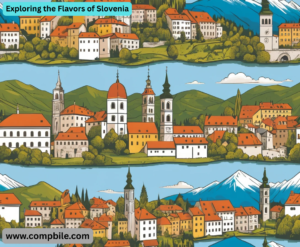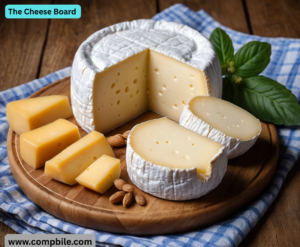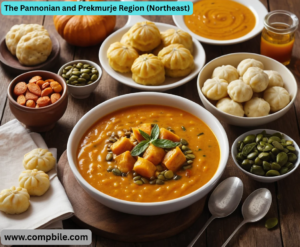Exploring the Flavors of Slovenia Of course! Exploring the flavors of Slovenia is a delightful journey through a landscape where Alpine, Mediterranean, and Pannonian (Hungarian-influenced) plains meet on a single plate. Slovenian cuisine is hearty, seasonal, and deeply connected to its terroir—a true “farm-to-table” experience centuries before the term was coined. Here’s a guide to the essential flavors of Slovenia.
The Guiding Principle: Farm Food (Farmhouse Food)
- Slovenian food isn’t about complexity; it’s about quality, simplicity, and seasonality. The core of the cuisine is what can be grown, foraged, or raised locally. This has evolved into a modern culinary philosophy that has put Slovenia on the world’s gastronomic map.
The Holy Trinity of the Slovenian Plate
- Bread : A sacred staple. No meal is complete without it, often homemade or from a local bakery. Look for dark rye breads and cornbread.
- Potatoes : Prepared in countless ways: boiled, roasted, in stews, or as the star of many dishes.
- Cabbage : Pickled as sauerkraut (a key ingredient), stuffed, or stewed.
Must-Try Dishes & Flavors
Hearty Soups & Stews
- Soups are a meal in themselves.
- Whom: The ultimate hearty stew. A robust combination of sauerkraut, beans, potatoes, and smoked pork (ribs or sausage), flavored with bay leaf and garlic. A taste of the Karst region.
- Mushroom Soup: A creamy wild mushroom soup, especially popular in the autumn foraging season.
- Burnt bread: A unique “burned” soup from the Prekmurje region. Flour is browned in fat (often pork cracklings), then thinned with water and enriched with eggs. Simple and comforting.
- Minestrone: A thick, minestrone-like vegetable soup from the Primorska (Littoral) region.
The Main Events
- Strudels: Perhaps Slovenia’s most iconic dish. These are rolled dumplings made from thin dough (often filo-like) that can be filled with sweet (apple, walnut, tarragon, cottage cheese) or savory (cheese, meat) fillings. They are boiled, baked, or steamed.
- Croissant: Small, signature dumplings from the Idrija region, similar to Italian tortellini. They are typically filled with potato, bacon, and herbs and served with a bakalca sauce (a rich lamb or mutton stew).
- Carniolan Sausage: The famous Carniolan sausage. A protected (PGI) sausage made from high-quality pork (at least 68-80%), bacon, garlic, and pepper. It’s smoked and must be a specific size. Served with sauerkraut and mustard.
- Bograc: A spicy, meaty stew from Prekmurje, named after the pot it’s cooked in. Contains three types of meat (usually pork, beef, and game), potatoes, onions, paprika, and wine.
- Prosciutto: Air-dried ham, similar to Italian prosciutto or Croatian pršut. The best comes from the Karst region (Kraški pršut), where the burja wind perfectly cures it. Served thinly sliced as an appetizer.
From the Sea & Mountains
- Istrian & Coastal Specialties: On the tiny coastline, the influence is thoroughly Mediterranean.
- Fritaja: A hearty omelette or frittata, often with wild asparagus, truffles, or herbs.
- Seafood: Fresh fish, squid, and mussels are simply grilled or stewed.
- Game & Forest: In the inland and Alpine regions, you’ll find:
- Dovek (Venison) and Srnjak (Roe deer) often prepared as goulash or roasted.
- Richet: A thick, barley-based stew with beans, potatoes, and smoked meat.
The Cheese Board
- Slovenia takes its cheese very seriously.
- Tolminc: A famous semi-hard, mild cow’s milk cheese from the Tolmin area. A protected cheese.
- Bovec Sir: A hard, pungent, aged cheese from the Bovec region.
- Mohant: An acquired taste! A soft, rind-washed, intensely aromatic and pungent cheese from the Bohinj area.
- Trnic : A unique, hard, smoked cheese from the Bohinj region, traditionally made by shepherds for their loved ones. It’s shaped into a distinctive pair of breasts.
- Skuta: A fresh, soft curd cheese similar to ricotta or quark, used in both sweet and savory dishes.
Sweet Finishes (Desserts)
- Potica: The undisputed queen of Slovenian desserts. A rolled yeast dough nut filled with a vast array of fillings. The most traditional is orehova (walnut), but you’ll find tarragon, hazelnut, poppy seed, and even chocolate.
- Gibanica: A “messy cake” from Prekmurje. A layered pastry with a delicious, heavy filling of poppy seeds, walnuts, apples, raisins, and cottage cheese.
- Kremna Rezina / Cream cheese: The famous cream cake from Lake Bled. A layer of vanilla custard and a layer of whipped cream sandwiched between thin puff pastry. A must-try.
- Strudels: Don’t forget they can be sweet! Sweet cheese or apple dumplings are a classic dessert.
What to Drink
Wine: Slovenia is a spectacular, under-the-radar wine country with three main regions:
- Exploring the Flavors of Slovenia Primorska: Known for powerful reds like Refošk and Teran, and Italian-style whites (Malvasia, Vitovska).
- Podravje: Known for elegant whites like Renski Rizling (Riesling), Shipon(Furmint), and Traminec (Gewürztraminer).
- Posavje: Known for blended wines like Cviček—a unique, light, slightly sour pink wine made from red and white grapes.
- Beer: The main brands are Laško (green bottle) and Union (blue bottle). A thriving craft beer scene is also exploding in Ljubljana and beyond.
- Brandy/ Fruit tree: The general term for fruit brandy or schnapps. Plum wine (plum) and Viljamovka (pear) are very common. A small glass is often offered as a welcome drink.
The Modern Culinary Scene
- Slovenia is a global foodie destination thanks to its innovative chefs who reinterpret these traditional flavors. The country boasts a remarkable number of Michelin-starred restaurants and the world’s first “green” Michelin star for sustainable gastronomy, awarded to Hiša Franko (chef Ana Roš).
How to Experience It:
- Visit an Gostilna: A traditional inn, the best place to get authentic, home-style cooking.
- Go to an Open Market (Market): See the fresh, local produce, cheese, and meats.
- Attend a Food Festival: Like the October “Okusno” in Ljubljana or the “Taste Radol’ca” festival.
- Order the “Tourist Menu”: Many places offer a sampler plate of classic dishes, perfect for first-timers.
The Soul of Slovenian Dining: The Gostilna
To truly understand Slovenian food, you must step into a gostilna. This is not just a restaurant; it’s a traditional inn, often family-run for generations, serving hyper-local, home-cooked food. The menu changes with the season and what’s available. The ambiance is warm, wooden, and unpretentious. Finding a good gostilna is finding the authentic soul of Slovenia.
A Regional Culinary Map
- Slovenia’s flavor profile shifts dramatically every 50 kilometers. Here’s a breakdown:
The Alpine & Upper Carniola Region (North & Northwest)
- Character: Hearty, meaty, and designed to warm you up in a cold climate. Think potatoes, cabbage, sausages, and dairy.
Must-Tries:
- Exploring the Flavors of Slovenia Žganci: Not a dish but a staple side. Buckwheat or barley flour porridge that’s boiled, then fried into crumbs. It’s the ultimate comfort food, often served with stews or just poured over with prežganka (browned fat with cracklings).
- Kranjska Klobasa: The king of this region.
- Strudels: In their many forms, both savory and sweet.
- Game Meat: Venison, wild boar, and rabbit stews.
The Karst & Littoral Region (Southwest)
- Character: A sun-drenched taste of the Mediterranean. Heavily influenced by Italy, with olive oil, herbs, seafood, and wine taking center stage.
Must-Tries:
- Karst Prosciutto: The renowned air-dried ham, best enjoyed with a glass of Teran wine.
- Frittata with white truffles:An omelette with exquisite white truffles, foraged from the forests near Motovun (which spills over from Croatia).
- Malvasia: The iconic crisp, aromatic white wine of the Istrian coast.
- Minestrone: The local, thick version of the classic soup.
The Pannonian and Prekmurje Region (Northeast)
- Character: Flat, fertile plains mean paprika, pumpkin oil, grains, and freshwater fish. The influence from Hungary and Austria is strong here.
Must-Tries:
- Bograc: The spicy, triple-meat stew.
- Prekmurje Gibanica: The legendary multi-layered pastry. This is a non-negotiable dessert here.
- Pumpkin Oil: Pumpkin seed oil, dark, nutty, and drizzled over salads, soups, and even ice cream.
- Turkey soup with gnocchi: A rich turkey soup with small dumplings.
The Central & Lower Sava Valley (Southeast)
- Character: A mix of influences, known for its orchards, fields, and unique dishes.
Must-Tries:
- Styrian Sour Soup: Styrian sour soup, made from a base of fermented rye flour, giving it a unique tangy flavor.
- Apple Orchards: This region produces excellent cider and apple-based dishes.
The Rituals of Eating
- Exploring the Flavors of Slovenia Breakfast (Breakfast): Typically light. Coffee, bread with jam, honey, or premurska šunka (a cooked ham), and maybe yogurt.
- Lunch (Lunch): This is the main meal of the day. Slovenians often go home for a proper, hot lunch between 12 and 2 PM. It traditionally consists of a soup, a main course (with meat, a starch, and a salad), and a dessert.
- Dinner (Dinner): Usually a lighter, often cold meal—similar to breakfast or leftovers from lunch. The concept of a large, heavy dinner is less common.
The Modern Revolution: From Gostilna to Gourmet
- Exploring the Flavors of Slovenia While tradition is sacred, Slovenia’s food scene is brilliantly innovative. This is driven by a philosophy of localism and sustainability.
- Franko’s House (Kobarid): Chef Ana Roš, of “Chef’s Table” fame, forages and sources hyper-locally to create breathtaking dishes that tell a story of her terrain. This is the epicenter of modern Slovenian gastronomy.
- Denk House (Upper Kungota): Another top restaurant focusing on “zero-kilometer” cuisine, where almost everything is grown on their own farm.
- Strelec Restaurant (Ljubljana): Located in the castle, it offers modern interpretations of Slovenian classics with stunning views.
- The “Green” Movement: Slovenia is a world leader in sustainable tourism and food. The emphasis on organic farming (eko kmetije), farm stays, and foraging is deeply ingrained. This isn’t a trend; it’s a return to their roots.
Practical Tips for the Culinary Traveler
- Learn the Lingo: A few key words go a long way.
- Inn = Traditional inn
- Good run = Enjoy your food (say it before you eat!)
- Cheers = Cheers! (literally “to health”)
- Pivo = Beer
- Dnevna meni = Daily menu (the best and cheapest lunch option)
- Seek Out Agritourism (Tourist Farm): The ultimate food experience. These are working farms that offer meals (often massive, multi-course feasts) and sometimes accommodation. You eat what they grow.
- Visit a “Vinoteka”: A wine cellar where you can taste local wines from the region. The ones in Vipava Valley and Maribor are exceptional.
- Forage for Your Food: Slovenia has a right-to-forage law. Joining a guided foraging tour to find wild mushrooms, asparagus, or herbs is an unforgettable way to connect with the landscape and its flavors.




